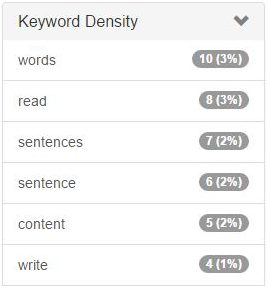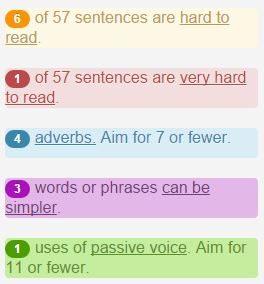What makes content good? These things:
- Tone and style: does it make the reader feel the way you need them to feel and is it pleasant to read? Is it appropriate and does it sound like you?
- Readability: Can your target audience read and understand it?
- Usefulness: Is it relevant? Will people benefit from reading it?
- Organisation: Have you split it up with useful headings as markers, so people can skip to the bit they want?
And guess what? These things are important for your search engine value too. So that’s two good reasons to test what you write.
Use these tools to help you write useful, readable content
Wordcounter.net – www.wordcounter.net
1. Counts words (obviously)
This is useful because although you should never crank out nonsense in the vain hope of attracting more traffic, clever people have proved that longer content is linked to better search engine ranking.
I’ve seen for myself that posts over 800 words get longer time on page and also more social shares than a quick 300 word note. You need to work out the right content length for your audience, but keep in mind that ‘short and sweet’ doesn’t always play out.
2. Measures sentence length
Sentences need to be shorter online so readers can skip to the content they want.
We know from eye-tracking studies that people read the first few words of a sentence to get the meaning, then check with a few words at the end. So if your sentences are short, your audience will find it easier to grasp your point.
Most experts advise sentences of between 12 and 20 words. You might find that unmanageable at first, but the trick is stop making multiple concepts share one sentence. Each separate point deserves the reader’s full attention, so give it a separate sentence or more.
Varying your sentence lengths and structure is important too. Too many shorty short sentences and your blog will read like a child’s story. Too many long sentences and it’ll read like the Bill of Rights. Mix it up! Just remember that you wouldn’t want your average sentence length to be 12 words because that would say that you’re writing too many short sentences. Aim for the middle: around 16.
 3. Works out your keyword density
3. Works out your keyword density
Now, this is literal: key WORD. Like in the old days when you could ‘SEO’ a site with a list of single words in the meta data. I would only use this feature as a helpful notice of whether you’ve got enough focus on your key topics in the post you’ve ALREADY WRITTEN.
You can also turn on an option for the keyword density tool to pick up common words: this lets you see if you have any semantic ticks, like using ‘simply’ too much. By clicking on words in the list, Word Counter will highlight them for you so you can weed them out easily.
Hemingwayapp.com – www.hemingwayapp.com
It’s often said that Hemingway is the most readable author of all time, and that’s clearly what the developers of this handy writing tool thought.
1. Tells you the reading age
This measures your post by American school grade, which means a person educated up to that grade could read and understand it. W3C (the overlords of the internet) suggest that a reading age of around 14 is desirable (half of UK working adults have a reading age of 11 or lower) – so write for Grade 9 or below.
2. Highlights areas to improve

This includes hard-to-read sentences, adverbs (very, truly, obviously, strongly, probably, potentially, usefully – which are a bit weak when you could go straight in for the kill with your big bold point), phrases that could be simplified, and the passive voice.
When you hover over one of these highlighted words, Hemingway will give you a suggestion for a better word or just tell you to get rid of it. This is great for writing business blogs, especially if you’re a B2B company. It’s tempting to stick with tradition over what actually works, but keep things simple and enjoyable to read above anything else.
3. Saves your work
Hemingway also has a desktop version but the online site will remember what you wrote even if you close the window, so you can go away and come back. Amazing.
Let’s put it to the test
Whenever I write about writing, I always put my own content to the test. It wouldn’t be fair for me to preach what I don’t practise, would it?
I also ran this content against a web page of the same length from a technology provider, using a combination of Wordcounter.net and Hemingwayapp.com.
| My content: | Comparison content: |
| Average sentence length: 17 words | Average sentence length: 30 words |
| Hard-to-read sentences: 12% | Hard-to-read sentences: 57% |
| Adverbs: 4 | Adverbs: 5 |
| Passive voice: 3 uses | Passive voice: 7 uses |
| Reading age: Grade 6 | Reading age: Grade 20 |
| Top five keywords: words, read, sentence, content, read, write | Top five keywords: [brand name], industry, solutions, customers, sectors |
Now, you might say that a tech company is going to naturally have more complicated concepts to write about – but look at the keywords. Most of those words mean nothing and don’t give search engines a nice semantic field (group of related words) that is relevant to what people are searching.
‘Solutions’ is my pet hate. If you’re selling solutions, tell me what the solution is! It’s like a secret code for what your company really does – which isn’t very useful when you’re trying to attract people who are interested in that thing and make them buy it.
You do want to get found for your brand name, sure, but that only attracts people who have heard of you. What about all the people who desperately need what you have but don’t know you exist?
I’ve tested against this company to prove a point but you could choose a company whose content (or success) you admire and test your posts against theirs. What are they doing that you’re not?
[bctt tweet=”Keep website and blog content readable with testing tools from @wordcounter_net and @HemingwayApp.”]
